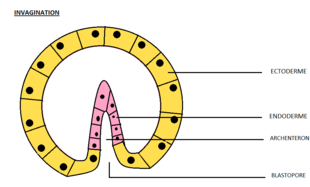31:
151:
208:, invagination is the first mechanism that takes place during gastrulation. The four largest endoderm cells induce the invagination process in the tunicates. Invagination consists of the internal movements of a sheet of cells (the endoderm) based on changes in their shape. The blastula of the tunicates is a little flattened in the
64:
There is more than one type of movement for invagination. Two common types are axial and orthogonal. The difference between the production of the tube formed in the cytoskeleton and extracellular matrix. Axial invagination can be formed at a single point along the axis of a surface. Orthogonal
212:
making a change of shape from a columnar to a wedge shape. Once the endoderm cells were invaginated, the cells will keep moving beneath the ectoderm. Later, the blastopore will be formed and with this, the invagination process is complete. The blastopore will be surrounded by the
57:. In each organism, the complexity will be different depending on the number of cells. Invagination can be referenced as one of the steps of the establishment of the body plan. The term, originally used in
330:
225:
In geology, invagination is used to describe a deep depression of strata. Used by Donald L. Baars in "The
Colorado Plateau".
136:
334:
113:, thus providing a much greater surface area to accommodate the protein complexes and other participants that produce
283:
258:
164:
is the first cell movement of gastrulation. This process was first described by
Conklin. During gastrulation, the
406:
379:
17:
176:
will be gone transforming into a cup-shaped structure with a double wall. The inner wall will be called the
102:: endoderm, mesoderm, and ectoderm. More localized invaginations also occur later in embryonic development,
53:. Invagination consists of the folding of an area of the exterior sheet of cells towards the inside of the
401:
114:
42:
8:
349:
247:
375:
279:
254:
41:
is the process of a surface folding in on itself to form a cavity, pouch or tube. In
87:
395:
106:
75:
30:
209:
193:
180:; the primitive gut. The archenteron will open to the exterior through the
86:, the massive reorganization of the embryo from a simple spherical ball of
83:
50:
46:
177:
121:
181:
173:
128:
when a vesicle forms within the cell and the membrane closes around it.
125:
99:
58:
205:
189:
160:
132:
214:
185:
169:
165:
95:
91:
54:
150:
110:
79:
240:
238:
49:. This mechanism or cell movement happens mostly in the
45:, invagination is a mechanism that takes place during
235:
246:
172:will fold towards the inner part and that way the
61:, has been adopted in other disciplines as well.
253:. Sunderland, Massachusetts: Sinauer Associates.
393:
374:. Canada: CBS College Publishing. p. 599.
273:
168:will be transformed by the invagination. The
244:
274:Gilbert, Scott; Barresi, Michael (2016).
149:
29:
369:
313:
82:takes form, and is the initial step of
14:
394:
298:
278:. Massachusetts: Sinauer Associates.
249:Embryology, Constructing the Organism
245:Gilbert, Scott; Rauno, Anne (1997).
154:Invagination process in an amphioxus
65:invagination is linear and trough.
24:
347:
25:
418:
328:
184:. The outer wall will become the
27:Process in embryonic development
363:
341:
322:
307:
292:
267:
131:Invagination of a part of the
13:
1:
316:Molecular Biology of the Cell
228:
318:. New York: Garland Science.
199:
143:
135:into another part is called
7:
120:Invagination occurs during
10:
423:
301:Mechanisms of Morphogensis
220:
68:
331:"Biochemistry Dictionary"
299:Davies, Jamie A. (2013).
34:Mechanism of invagination
105:The inner membrane of a
94:, into a multi-layered
370:Browder, Leon (1984).
155:
115:adenosine triphosphate
98:, with differentiated
78:processes by which an
35:
407:Developmental biology
372:Developmental Biology
276:Developmental Biology
153:
43:developmental biology
33:
188:. Later forming the
158:The invagination in
109:invaginates to form
74:Invagination is the
402:Cellular processes
156:
36:
350:"Intussusception"
16:(Redirected from
414:
386:
385:
367:
361:
360:
358:
356:
345:
339:
338:
333:. Archived from
326:
320:
319:
314:Alberts (2002).
311:
305:
304:
296:
290:
289:
271:
265:
264:
252:
242:
21:
422:
421:
417:
416:
415:
413:
412:
411:
392:
391:
390:
389:
382:
368:
364:
354:
352:
348:Blanco, Felix.
346:
342:
327:
323:
312:
308:
303:(2nd ed.).
297:
293:
286:
272:
268:
261:
243:
236:
231:
223:
202:
148:
137:intussusception
71:
28:
23:
22:
15:
12:
11:
5:
420:
410:
409:
404:
388:
387:
380:
362:
340:
337:on 2012-11-14.
321:
306:
291:
284:
266:
259:
233:
232:
230:
227:
222:
219:
217:by all sides.
201:
198:
147:
142:
141:
140:
129:
118:
103:
70:
67:
26:
9:
6:
4:
3:
2:
419:
408:
405:
403:
400:
399:
397:
383:
377:
373:
366:
351:
344:
336:
332:
329:Cronk, Jeff.
325:
317:
310:
302:
295:
287:
285:9781605354705
281:
277:
270:
262:
260:0-87893-237-2
256:
251:
250:
241:
239:
234:
226:
218:
216:
211:
207:
197:
195:
191:
187:
183:
179:
175:
171:
167:
163:
162:
152:
146:
138:
134:
130:
127:
123:
119:
116:
112:
108:
107:mitochondrion
104:
101:
97:
93:
89:
85:
81:
77:
76:morphogenetic
73:
72:
66:
62:
60:
56:
52:
48:
44:
40:
32:
19:
18:Invaginations
371:
365:
353:. Retrieved
343:
335:the original
324:
315:
309:
300:
294:
275:
269:
248:
224:
210:vegetal pole
203:
194:neural crest
159:
157:
144:
84:gastrulation
63:
51:vegetal pole
47:gastrulation
39:Invagination
38:
37:
178:archenteron
122:endocytosis
100:germ layers
396:Categories
381:4833702010
355:1 November
229:References
182:blastopore
174:blastocoel
126:exocytosis
59:embryology
206:tunicates
200:Tunicates
190:epidermis
161:amphioxus
145:Amphioxus
133:intestine
215:mesoderm
186:ectoderm
170:endoderm
166:blastula
96:organism
92:blastula
55:blastula
221:Geology
111:cristae
69:Biology
378:
282:
257:
117:(ATP).
90:, the
80:embryo
88:cells
376:ISBN
357:2012
280:ISBN
255:ISBN
192:and
124:and
204:In
398::
237:^
196:.
384:.
359:.
288:.
263:.
139:.
20:)
Text is available under the Creative Commons Attribution-ShareAlike License. Additional terms may apply.

